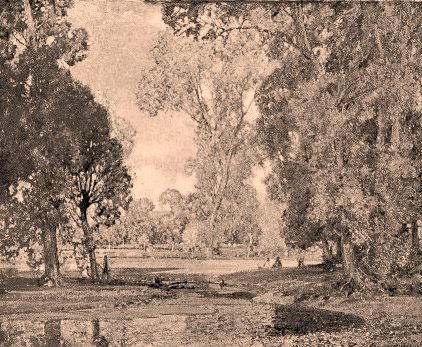
undulations of the fields appear to follow. Upon this imaginary line everything rests, and it must be felt in any landscape that aspires to strength and certainty.
The landscape painter must carefully study the influence of atmosphere upon the lessened dimensions of remoter objects, and remember that his tone values must be just, and this is intimately associated with the truth of aerial perspective. For instance, if a yellow tree appears on the same plane as a green one in an autumn landscape, it will be easy enough to portray them in their right size in relation to your foreground. But a difficulty may arise when you try to paint them both in the same atmospheric plane. It stands to reason that, if an equal breadth of air intervenes between you and both trees, you have a colour problem to deal with now, for it is essential that they appear by reason of colour as well as size to be at the same distance from the observer. The lesson to bear in mind is, that your aerial hersfiective must always be consistent with your linear perspective.
Remote objects occasion difficulties, no doubt, but do not try to make them recede by diluting your foreground colour by the addition of white. You cannot reach the result by such means; you must have a different set of pigments. The strong hues of your foreground, broken, as in Nature, into a hundred details, may be composed of cadmium of three grades of strength, of rose madder, and white, with burnt sienna broken with white and transparent emerald oxide of chromium, and transparent golden ochre. All these are broken together on your picture (see Chapter III., Sketching from Nature," p. 14), not mixed on your palette. But for the extreme distance your colour should be mixed on your palette. For the intermediate distance you use paint not so flat as in the extreme distance, but not so broken as in your foreground.
You have now, with plenty of paint and very little medium, practically repainted your picture.You have gone over most of the surface, except perhaps the shadows, which should not be thickly painted. You have modelled your trees, painted the middle distance, prepared the foreground with broken colour, and, above all, you have retained the original freshness of your effect- that first impression which imparted vitality to the subject.
Now let me speak of the sky. It is as you left it in your first painting-merely a ground of white, toned with yellow ochre. You will probably have seen many cloud forms pass during your work up to this point, and you know in your mind, which will best harmonise with your composition. But still it is better to watch when your effect comes on, so that you may note the particular colour of the sky in relation to the trees, and in the same relation of colour paint it in your picture. But one moment-the form of the clouds that you perceive yonder may or may not suit your scheme. You will be fortunate indeed if they harmonise absolutely. No matter how beautiful your clouds may be, if they do not suit the contours of your picture you must avoid them, and accept only such as support and complete it, and are consistent with the character of the day. You must paint the sky again with the same tint as you used previously, a little warmer at the horizon, and cooler above. Then mix the blue on your palette, rather more strongly than is really needed, for the reason which I have already explained.
You are now ready. You watch for your effect, which is coming on. You know it occurs at the moment of impact of that shadow upon the mass of trees which you have noted before. It is the supreme crisis when everything, as it were, will sing in tune. The clouds roll majestically forward and reveal the very form you desire. You are, of course, standing at your easel. No man ever painted a great sky sitting. You hold your breath in the excitement of the moment, you know what it means to your work; but do not hesitate, do not flinch. Take up the blue
|
5 |